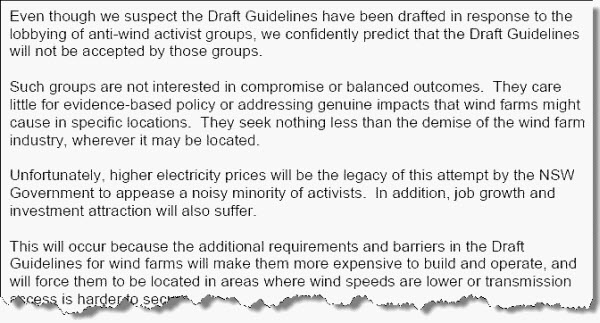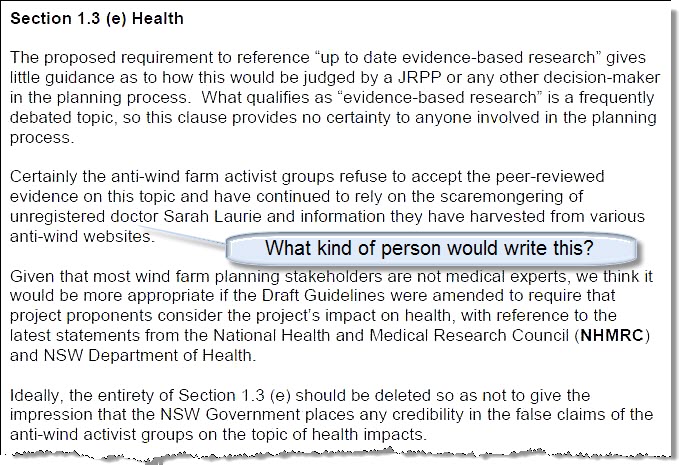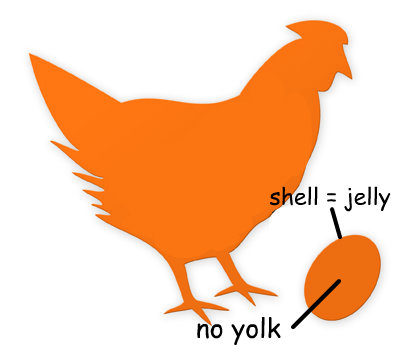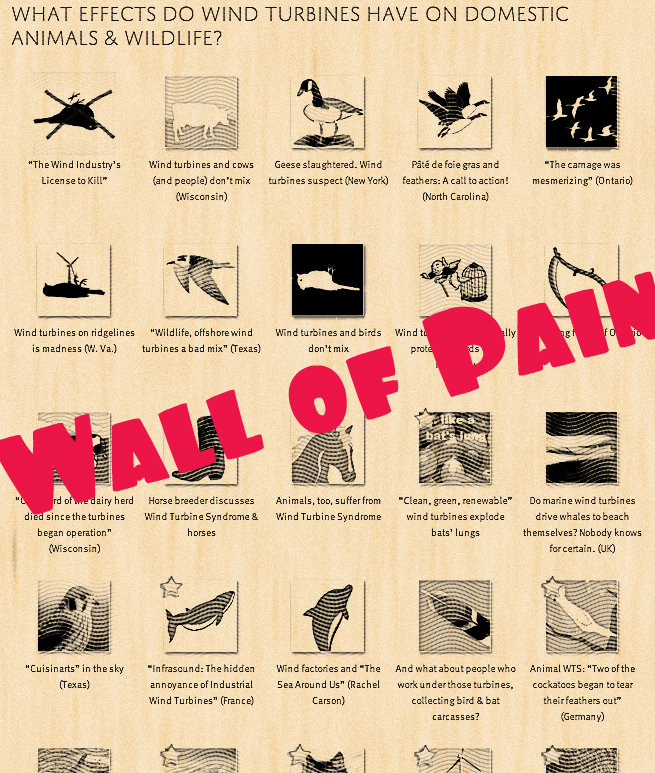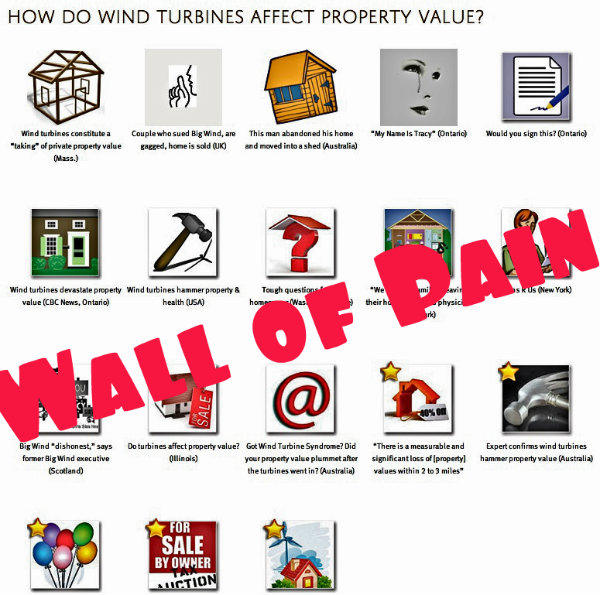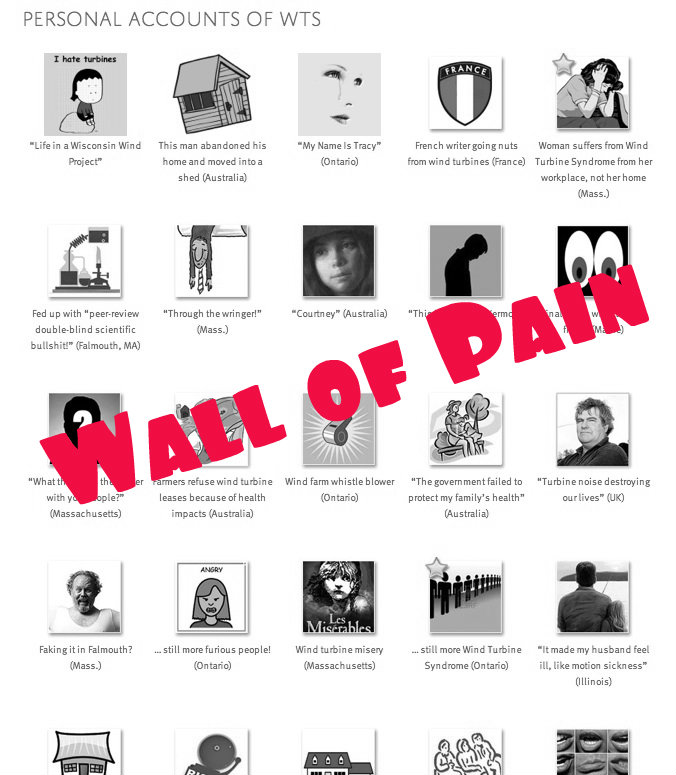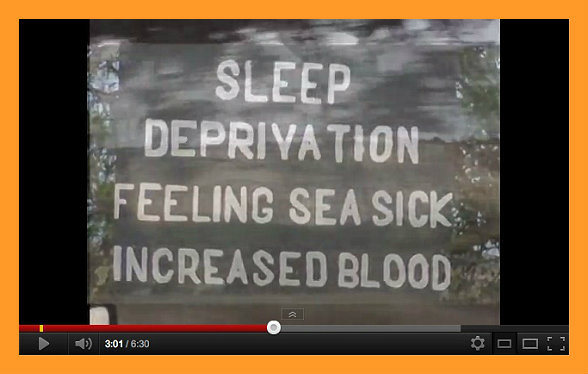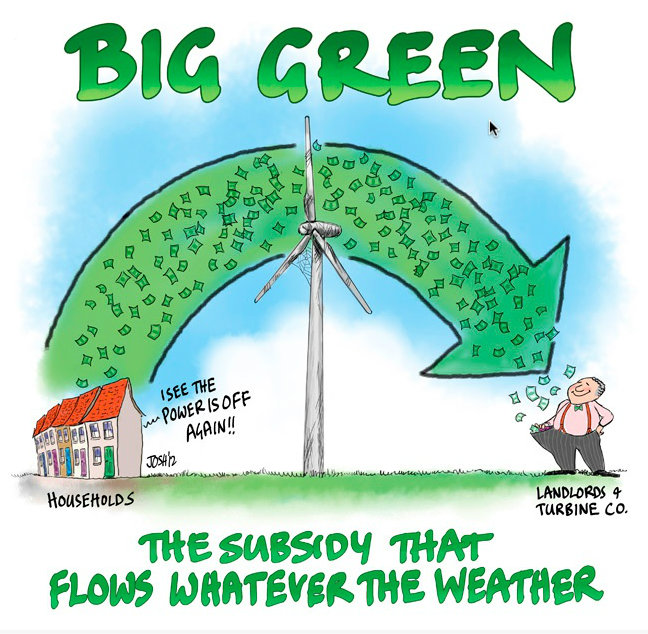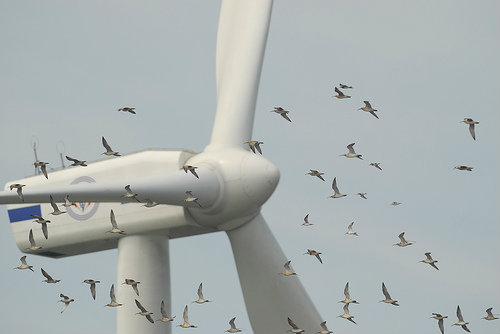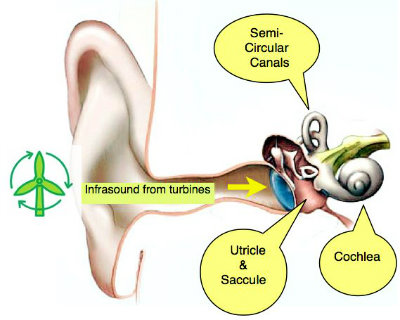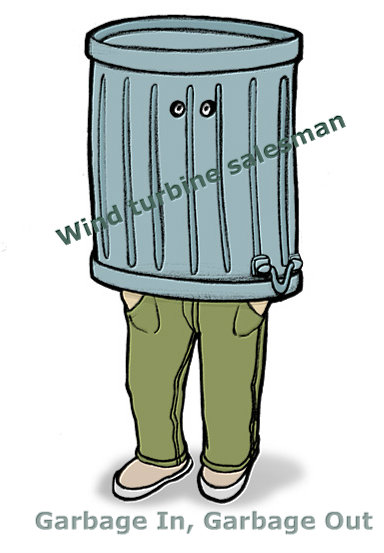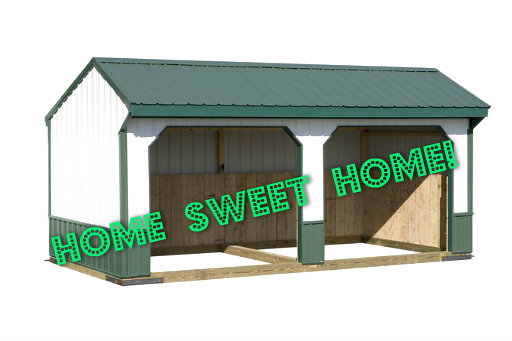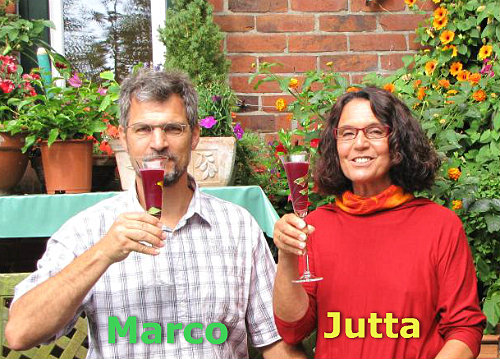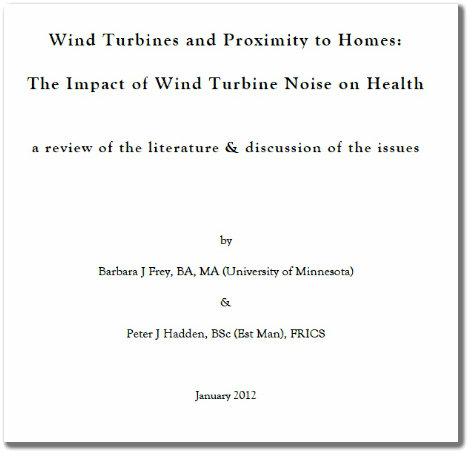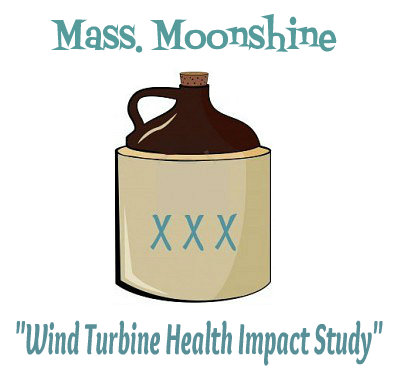
Helen Schwiesow Parker, Ph.D. (Chilmark, MA)
Licensed Clinical Psychologist
Past Clinical Supervisory Faculty, University of Virginia Medical School
Past Director, Purdue Univ. Achievement Center for Children
Click here for a PDF of the following document.
3/18/12
The purpose of this document is to respond to the Wind Turbine Health Impact Study: Report of Independent Expert Panel of January 2012, which was prepared for the Massachusetts Department of Environmental Protection, Massachusetts Department of Public Health.
I’ve been given the opportunity to review the Martha’s Vineyard Commission [3-16-12 draft] Comments on the draft Massachusetts Wind Turbine Health Impact Study, directed to Commissioners Auerbach and Kimmell. Below, “MVC” comments are in blue. Emphasis throughout is mine.
The MVC’s initial characterization of the DEP/DPH Health Study is that it is “a useful, though limited, literature review.” [Did the independent experts just not have TIME to examine very much of the evidence submitted?] Next the MVC notes their concern that “the wording of some conclusions is ambiguous and could lead to misinterpretations that understate the actual or potential health impacts of wind turbines….
“The MVC is concerned that this study might be used as the basis for adoption of excessively permissive state-wide standards that would then be imposed on municipalities with statewide superseding regulations, such as the currently tabled Wind Energy Siting Reform Act….
“‘Absence of Proof of Health Impacts’ is Not the Same as ‘Proof of Absence of Health Impacts.’ The study is often unclear as to whether there is demonstrated evidence that a potential impact does not exist, or whether conclusive studies have not yet been carried out with respect to that factor. [Is this just a BADLY written report? Unintentionally ambiguous, unclear with unjustified conclusions?] In the absence of clear evidence that a given factor is not a problem, it would seem wise to err on the side of caution with respect to development of potentially problematic wind energy projects….
“The report’s ambiguous language about this has already lead to questionable interpretations about the report, such as the Conservation Law Foundation’s statement that “This new, independent study advances the state of science and debunks common misunderstandings regarding potential health impacts of wind turbines.” The study should make clear that it is a partial literature review that summarizes some existing science and does not advance it. It should be made clear that the study’s use of the term “limited epidemiologic evidence” does not imply that these impacts should be ignored, and the current absence of definitive scientific proof that wind turbines directly cause a specific health impact does not necessarily “debunk” contentions that this might be the case….
“In the absence of definitive studies clearly indicating the absence of significant impacts, the Martha’s Vineyard Commission suggests that the Commonwealth of Massachusetts…apply the Precautionary Principle, which states that if an action or policy has a suspected risk of causing harm to the public or to the environment, in the absence of scientific consensus that the action or policy is or is not harmful, the burden of proof that it is not harmful falls on those taking the action….
“For infrasound, the study indicates that ‘A possible coupling mechanism between infrasound and the vestibular system . . . has been proposed but is not yet fully understood or sufficiently explained. Levels of infrasound near wind turbines have been shown to be high enough to be sensed by the OHC [Outer Hair Cells]. However, evidence does not exist to demonstrate the influence of wind turbine-generated infrasound on vestibular mediated effects in the brain.’ This does not justify concluding that there is no link; it merely indicates that these robust studies have not been carried out yet. The study suggests that there doesn’t appear to be a logical explanation for a possible impact of low energy sound levels on the vestibular systems and concludes that it is not worth carrying out further studies about this issue.” (!)
This is a courageous piece. It is nevertheless restrained in tone as perhaps befits a governmental agency. As a colleague wrote recently, “I was raised that ‘you catch more flies with honey than you do with vinegar,’ but when you’re dealing with thieves & liars, that motto is no longer effective. Even Jesus turned over the tables in the temple on the hypocrites peddling their wares in His house! This country is OUR house! I say it’s time to let them know, ‘We’re mad as hell, and we are NOT going to take it anymore!’”
These are liars and thieves. This report is neither independent nor expert. And its consequences are neither abstract nor academic. Had this limited, unclear, ambiguous report with its unjustified conclusions which understate potential health impacts, leading to misinterpretations and tempting ludicrous claims that it advances science and debunks the validity of observation and self-reports of the impact of turbines on the health of those nearby…. had this report not come out biased, disingenuous and misleading as it did, those trying to stave off the erection of the two behemoths in Fairhaven might have been better able to persuade others in that fair city of the harm soon to be visited upon them.
Their quality of place has been stolen from the residents of Sconticut Neck, Little Bay Woods, and Peirce’s Point. The report is a lie as bald as that put forth by Sumul Shah of Fairhaven Wind LLC, who brushed off audience concerns about flicker at a January wind forum, saying “they mostly occur before 7 a.m.” Think about that! “Flicker” [more accurately described as strobing] occurs across a broad range of time after sunrise and before sunset, which varies according to the season, at any time when the turbine blades which reach 400’ into the air intermittently block sunlight flowing down past the blades across a broad swath of landscape. Liars and thieves.
And what of the lies told consistently, attempting to rob true independent experts of their credibility and professional integrity. Let’s look at just one example from the MA DEP/DPH report. Referring to Wind Turbine Syndrome, A Report on a Natural Experiment (2009) by Nina Pierpont, MD, PhD, the MA DEP/DPH report states unequivocally: “limitations to the design employed make it impossible for this work to contribute any evidence to the question of whether there is a causal association between wind turbine exposure and health effects” (p24).
Well then! So much for Dr. Pierpont, honors graduate of Yale, MD from Johns Hopkins, PhD in population biology from Princeton. Note a different appraisal from her peer reviewers, Drs. Katz (epidemiology), Lehrer (otolaryngology), Haller (neurology), and Horn (population biology). All four reviews have been reprinted in their entirety in the book. As excerpted below:
Your high level of scientific integrity is revealed both in your [research] design decisions and in your writing…. You have laid a remarkable, high quality, and honest foundation for others to build upon…. [Y]ou have made a commendable, thorough, careful, honest, and significant contribution to the study of (what we can now call) Wind Turbine Syndrome.” —from the referee report by Ralph V. Katz, DMD, MPH, PhD, Fellow of the American College of Epidemiology, Professor and Chair, Department of Epidemiology & Health Promotion NYU College of Dentistry.
The careful documentation of serious physical, neurological and emotional problems provoked by living close to wind turbines must be brought to the attention of physicians who, like me, are unaware of them until now.” —from the referee report by Jerome Haller, MD, Professor of Neurology and Pediatrics (retired 2008), Albany Medical College, Albany, New York. Dr. Haller is a member of the American Academy of Pediatrics, the American Academy of Neurology (Child Neurology Section), and the Child Neurology Society.
Dr. Pierpont has gathered a strong series of case studies of deleterious effects on the health and well-being of many people living near large wind turbines. Furthermore, she has reviewed medical studies that support a plausible physiological mechanism directly linking low frequency noise and vibration (like that produced by wind turbines and which may not in itself be reported as irritating) to potentially debilitating effects on the inner ear and other sensory systems associated with balance and sense of position. Thus the effects are likely to have a physiological component, rather than being exclusively psychological….” —from the referee report by Henry S. Horn, PhD, Professor of Ecology and Evolutionary Biology, and Associate of the Princeton Environmental Institute, Princeton University.
What problems did the MA “expert independent” panel have with her study design? After having cherry-picked which evidence among the thousands of pages of material to ‘review,’ the panel essentially claimed Pierpont cherry-picked her subjects: “The way in which these participants were recruited makes it impossible to draw any conclusions about attributing causality to the turbines” (p25).
Time and again, the “expert” panel takes liberties with the scientific illiteracy of the public to distort the truth of what they purport to review. Over and over, I asked myself, which side of the stupid fence are they sitting on? As supposed experts equipped with the knowledge of statistics necessary to do a lit review, are they not even familiar with the significance of the “revealed preference measure”?
Sure, the lay public might nod and say, “yeah, she just picked the ones who said they were sick ‘cause they hate the turbines,” or “these guys are just complaining so they’ll get paid to shut up.” In fact, the families in Pierpont’s study all had spent or lost a lot of money trying to get away from the turbines, by selling their homes for reduced amounts, renting or buying a second home, renovating their homes in an attempt to keep out the noise, or outright abandoning their homes.
In epidemiology this is called “a revealed preference measure.” The people who are suffering show by their actions that their health problem is worth more than the thousands of dollars they have lost in trying to escape the exposure, and thereby distinguish their experiences from what might be dismissed as subjective or fakery.
Is the MA “expert” panel ignorant of this statistical nicety, or do they think we’re too stupid or so bludgeoned by their arrogance that we won’t call them on it?
In another instance of taking liberty with the scientific illiteracy of the public to distort the truth of what they purport to review, it’s important to examine the panel’s attempts to confuse, obfuscate, muddle and misuse the term “annoyance.”
Beginning with the “expert” panel report’s executive summary: “Most epidemiologic literature on human response to wind turbines relates to self-reported ‘annoyance,’ and this response appears to be a function of some combination of the sound itself, the sight of the turbine, and attitude towards the wind turbine project.”
Of course, “the public” tends to hear that term and think of a transitory state ranging from “merely” annoyed, to pretty annoyed to seriously annoyed, but in all events it doesn’t mean a person is getting sick over it. Whereas for the medical/mental health professional, there can be some very serious pathology in that ‘annoyance’ box. (See two-page endnote on “Annoyance.”)
Yet a panel member—Marc G. Weisskopf, ScD Epidemiology; PhD Neuroscience, Associate Professor, Department of Environmental Health & Epidemiology, Harvard School of Public Health—when asked by the press to give the clinical definition of “annoyance,” responded [approximate, not recorded verbatim]: “First of all, there is no clinical definition for ‘annoyance.’ The WHO doesn’t have one since what they see are ‘health effects’ instead. It is by some definitions a ‘self-reported’ effect and does not have a clinical significance.”
Oh, but it can have severe clinical significance! Once again, within the context of this biased and ambiguous report, it’s impossible not to conclude that we’re being toyed with, our appreciation of IWT health impacts intentionally manipulated with semantic games and worse. The panel is not expert or not independent, or both.
Back to the Pierpont study. Using a very robust case-crossover design, Pierpont gathered self-report data on symptoms before, during, and after exposure to the turbines. Within her subject families, all had at least one severely affected adult family member, and affected subjects had gone away from the wind turbines and seen their symptoms go away, and had come back and seen the symptoms return, generally several times. In epidemiology this is called a “case-crossover” design.
This statistical design is an unusually robust one and of choice in situations where both the exposure and the disease are transitory. People distance themselves from the turbines and their symptoms abate or disappear (until they’ve become ingrained over time, unfortunately). Back to the turbine area and the symptoms return. Despite infinite individual differences between subjects, Pierpont found symptom consistency statistically correlated with the presence or absence of the turbines.
What is it about the case-crossover design that causes the “expert” panel to claim that “limitations to the design employed make it impossible for this work to contribute any evidence to the question of whether there is a causal association between wind turbine exposure and health effects” (p24)? The best they can offer (and which just might be persuasive to the casual reader, but would be laughed out of a Psych 101 class): “There are also many factors that change when moving, making it difficult to attribute change to any specific difference with certainty”(p25).
Carl V. Phillips, MPP, PhD, is a Harvard-trained epidemiologist and professor of public health with outstanding credentials including a Robert Wood Johnson Foundation Scholars in Health Policy Research postdoctoral fellowship at the University of Michigan. In “Properly Interpreting the Epidemiologic Evidence about the Health Effects of Industrial Wind Turbines on Nearby Residents,” Bulletin of Science, Technology, and Society, vol. 31, no. 4 (August 2011), pp. 303-315, Phillips is direct in his dismissal of such biased nonsense:
Failure to understand how to draw scientific conclusions and myopia about a single method for modeling physical health effects are problematic, obviously. But they are not so clearly reprehensible, from an ethical standpoint, as telling people that their suffering does not really ‘count’ for some technical reason.”
Phillips introduces the above by summarizing: “There is overwhelming evidence that wind turbines cause serious health problems in nearby residents, usually stress-disorder type diseases, at a nontrivial rate…. There has been no policy analysis that justifies imposing these effects on local residents. The attempts to deny the evidence cannot be seen as honest scientific disagreement, and represent either gross incompetence or intentional bias.” Apply that to the MA DEP/DPH supposedly “Independent Expert” Panel’s Draft report, and you get the most succinct and fair assessment of as you’re going to find anywhere. Let’s hope the final version is markedly improved.
I’d like to turn here to a more constructive response to the MA Wind Turbine Health Impact Study. I’d like to offer my own expert independent position taken after over two years researching the topic, equipped with the following credentials:
I’m a Licensed Clinical Psychologist. My Ph.D. was earned from Purdue University, which is known for excellence in statistics, research design and interpretation. My doctoral dissertation was on PTSD (Post-Traumatic Stress Disorder). I’m a past Clinical Supervisory Faculty member at the University of Virginia Medical School, with a 6th year degree in Psychometry from Purdue, double Masters Degree in Special Education, past Director of Purdue’s Achievement Center for Children—a groundbreaking institution offering diagnostics and remedial programming in the field of sensory perception and learning disabilities—which draws clients from around the world. I began my career in 1970 as a teacher and administrator at New Haven’s Benhaven, the world-renowned private agency serving children, adolescents, and adults with autism and pervasive developmental disabilities.
My experience and training allow me to appreciate the subtle connections between the low frequency sound waves emitted by industrial scale wind turbines, and the Wind Turbine Syndrome (WTS). We’re not, after all, bionic man. We’re made of flesh and blood and very complicated moving parts ourselves. The sub-audible waves sent out by the turbines set up vibrations and resonance within the cavities of our bodies – ear, ocular orb, skull, our lungs and bellies – which make us nauseous and confused, and in many people provoke vertigo (a spinning dizziness), anxiety, blurred vision, tinnitus (painful ringing in the ears) headaches, tachycardia, difficulty with memory and concentration, panic episodes associated with sensations of movement or quivering inside the body that arise while awake or asleep. Of course they do. They are the ultimate and inescapable boom-box moved in next door. Imagine yourself unable to escape the pulsations.
In addition, I’m absolutely, crystal-clearly certain that, while nearby IWTs surely lead to sleep deprivation in some individuals [unhealthy in itself and which may lead to other significant health problems for those impacted], the effect of the turbine noise (whether “heard” as unnatural, percussive, threatening, “annoying”—or felt as infrasound, consciously or unconsciously) ….. the effect of turbine noise on mental health is direct, powerful, distinct from and additive to the turbines’ effect on sleep alone, significant as that is to health and wellbeing, safety and optimal functioning.
The “negative effect of the turbines on mental health” may to some extent, in some cases, result from the neurophysiological effects on the otolaryngological mechanisms suggested by Pierpont and elaborated by Salt. Yet other “negative effects of the turbines on mental health” clearly stand alone and outside this mechanism, perhaps with a causality more easily appreciated by the layperson. Remember that the Israeli army has used infrasound as crowd control for some years..… Put “infrasound interrogation” in your browser.
In many ways, the fundamentals of psychology are intuitive if the layman only stops to think or put oneself into another’s shoes. The effect of IWTs on mental health and wellbeing is no exception and must be factored into IWT siting decisions:
» Can we appreciate the hypersensitivity of the autistic child? Can we replicate it empathetically in our own sensory structure? What do you think is the impact of bombarding an autistic child with additive, strident, unpredictable, chronic, aversive stimuli?
» How many people who have chosen to live in semi-rural environments (now targeted for IWT installations) have a similar, albeit less radical, sensitivity to noise? How many chose to locate where their homes are simple shelters welcoming the outside in, for whom the idea of ‘sound mitigation’ from turbine noise fairly equals life in a padded cell? For what purpose?
» Is it so hard to imagine what our classmates experienced in the hellhole of Vietnam? The baggage returning with our Veterans from the Middle East? You’ve heard of PTSD: “Post Traumatic Stress Disorder” Do you know that the symptom constellation includes “intense psychological distress or physiological reactivity [heightened sensitivity] when the person is exposed to triggering events that resemble or symbolize an aspect of the traumatic event” [DSM-IV]? Is it so hard to relate to what the throbbing drone of the turbines bring back to their cellular storage of fear/terror/anxiety? Would you want it brought back, had you experienced it—once again up close and within earshot, but this time at home, where you had invested yourself and your future, believing you were now out of the war zone and safe? And what do we know about the health impacts of the stress hormone cortisol? Quite a bit.
» Beam yourself into the shoes of those with a history of migraine headaches, now exacerbated by the unpredictable whims of the wind. Do we dare entertain an image of what our neighbors suffer when these debilitating headaches now come (still) unpredictably but (now) exacerbated by these towers put up without public input (as in Falmouth, MA) or without informed public or political process (as throughout the world)?
» Add in the psychological distress engendered by the physiological destabilization which Pierpont describes with respect to balance mechanisms, nausea, tinnitus, vertigo, anxiety, panic attacks, memory and concentration loss.
» Add in the victims’ helplessness to effect change, betrayal by elected representatives whom we count on to protect our health and well-being, who now stonewall any consideration of our objective outrage of the clear torture waged on our persons. Add in the demands to fight these installations, on-goingly, with lives given over to complaint protocols, sound measurements, letters to representatives, discouraging consultations with group-hired attorneys, a desire to re-frame every social encounter either to score a point or to pretend this isn’t the center of your life.
You think all this doesn’t impact mental heath? Give me sleep disruption any day.
Health care professionals and academic investigators mustn’t limit their investigations into the health impacts of IWTs to sleep disruption and its direct consequences. Each of us can make this common-sensical argument to our elected representatives, take it to the streets, to the press. It’s a very important no-brainer for anyone open to listen for the truth.
.
Endnote on “Annoyance”
(1) In 1991, Suter commented that “Annoyance” has been the term used [in scientific studies] to describe the community’s collective feelings about noise ever since the early noise surveys in the 1950s and 1960s, although some have suggested that this term tends to minimize the impact. While “aversion” or “distress” might be more appropriate descriptors, their use would make comparisons to previous research difficult. It should be clear, however, that annoyance can connote more than a slight irritation; it can mean a significant degradation in the quality of life. This represents a degradation of health in accordance with the WHO’s definition of health, meaning total physical and mental well-being, as well as the absence of disease.” (p. 27)
Suter, A. H. (1991). Noise and its effects. Administrative Conference of the United States.
(2) Adults who indicated chronically severe annoyance by neighbourhood noise were found to have an increased health risk for the cardiovascular system and the movement apparatus, as well as an increased risk of depression and migraine.
Niemann H, Bonnefoy X, Braubach M, Hecht K, Maschke C, Rodrigues C, Robbel N. Noise-induced annoyance and morbidity results from the pan-European LARES study. Noise Health.
(3) “According to the World Health Organization (WHO), health should be regarded as “a state of complete physical, mental and social wellbeing and not merely the absence of disease or infirmity.”
“Under this broad definition, noise-induced annoyance is an adverse health effect.”
Michaud DS, Keith SE, McMurchy D. (2005). Noise annoyance in Canada. Noise Health 2005;7:39-47 [Note Dr. Mchaud is a staff member of Health Canada]
(4) Evidence/references by Respondents during the Ontario Environmental Review Tribunal Decision July 2011-10-03.
“The most common effect of community noise is annoyance, which is considered an adverse health effect by the World Health Organization.” Health Canada. Reference Submitted by Dr. Kenneth Mundt.
“…reputable research has shown that noise annoyance is an adverse health effect that can result from wind farms, as it can result in effects such as negative emotions and sleep disturbance.” General Purpose Standing Committee No. 5 Rural wind farms Ordered to be printed 16 December 2009 according to Standing Order 231 Reference submitted by Dr. Leventhall.
“No, I don’t disagree with your statement; annoyance is a health effect.” Transcript of Dr. C. Ollson, Mar, 22, 2011, p. 118, l. 4 to l. 21 testimony under oath by Dr. Christopher Ollson.
(5) “The audible sound from wind turbines, at the levels experienced at typical receptor distances in Ontario, is nonetheless expected to result in a non-trivial percentage of persons being highly annoyed. As with sounds from many sources, research has shown that annoyance associated with sound from wind turbines can be expected to contribute to stress related health impacts in some persons.”
Low frequency Noise and Infrasound Associated with Wind Turbine Generation Systems, A Literature Review, Ontario Ministry of Environment RFP Final Draft December 2010
(6) “References, both from peer-reviewed and other literature, acknowledge that IWTs may cause annoyance and/or stress and/or sleep disturbance (Colby et al., 2009 Minnesota Department of Health, 2009; Pedersen & Persson Waye, 2004, 2007; Rideout, Copes, & Bos, 2010; Thorne, 2010).”
Carmen M. E. Krogh, Industrial Wind Turbine Development and Loss of Social Justice? Bulletin of Science Technology & Society 2011 31: 321, DOI: 10.1177/0270467611412550 http://bst.sagepub.com/content/31/4/321
(7) Maschke et al. (2007) confirms chronic severe annoyance induced by neighbour noise must be classified as a serious health risk.
Maschke, C., Niemann, A. Health effects of annoyance induced by neighbour noise. Noise Control Eng. J. 55 (3), 2007 May-June.








